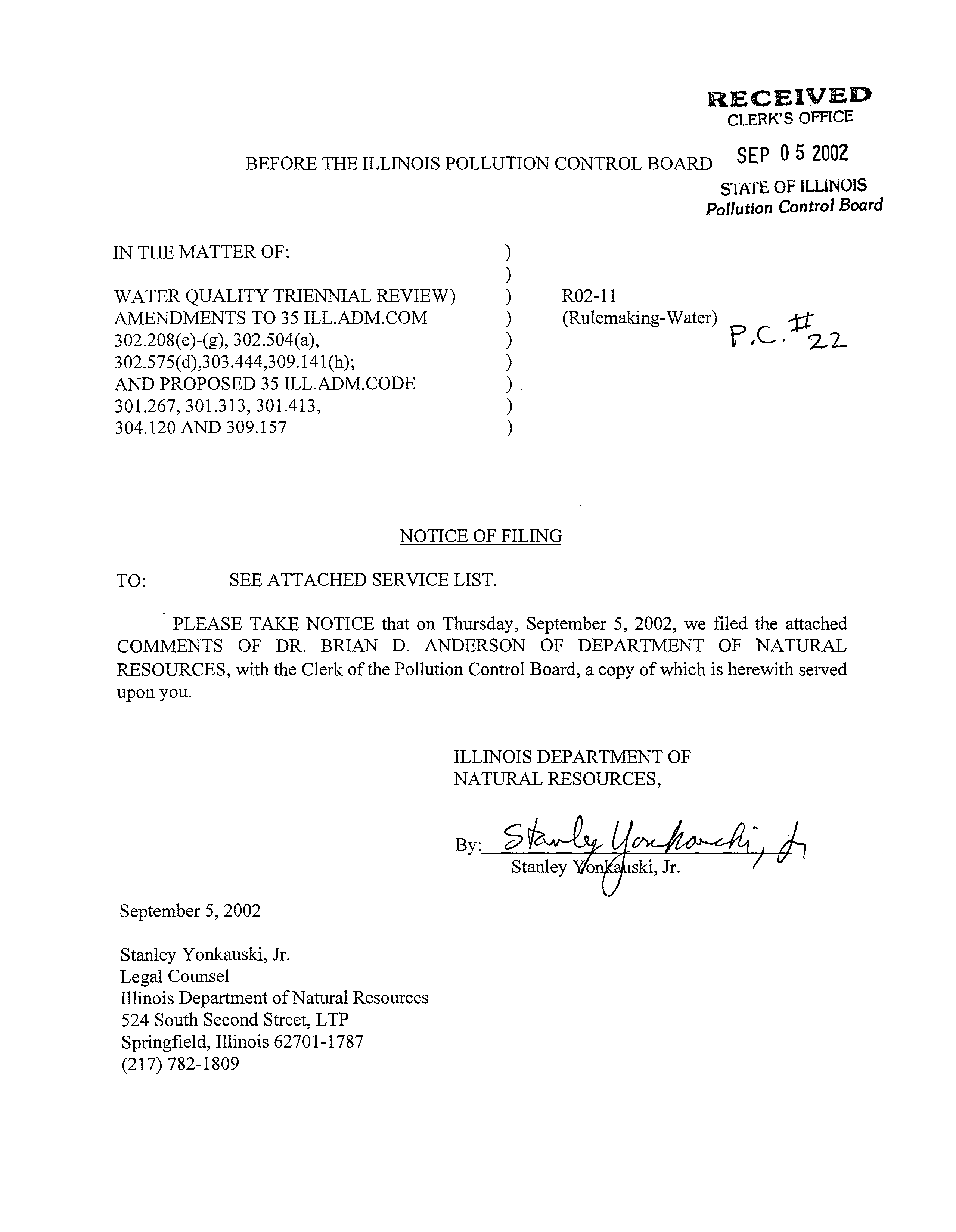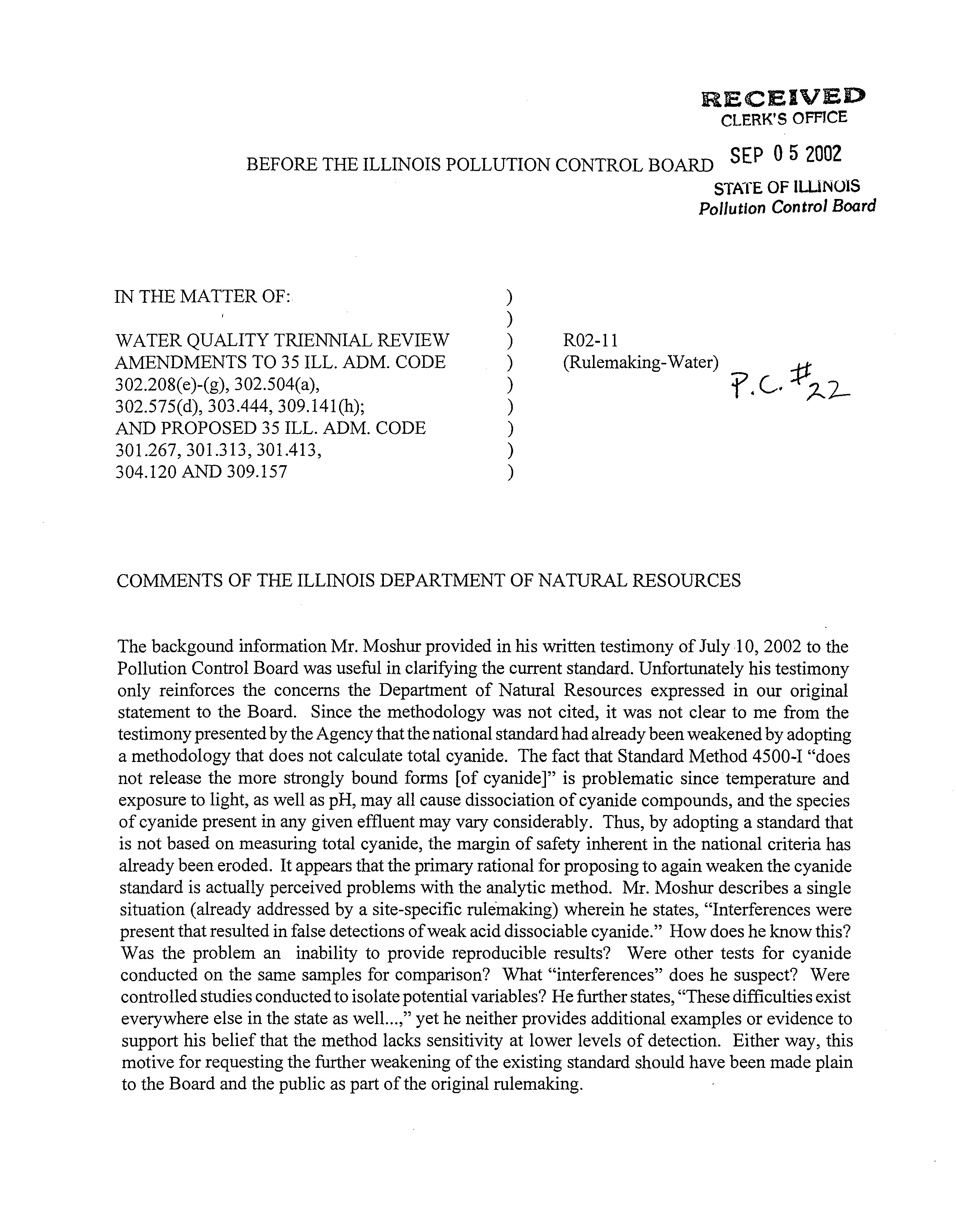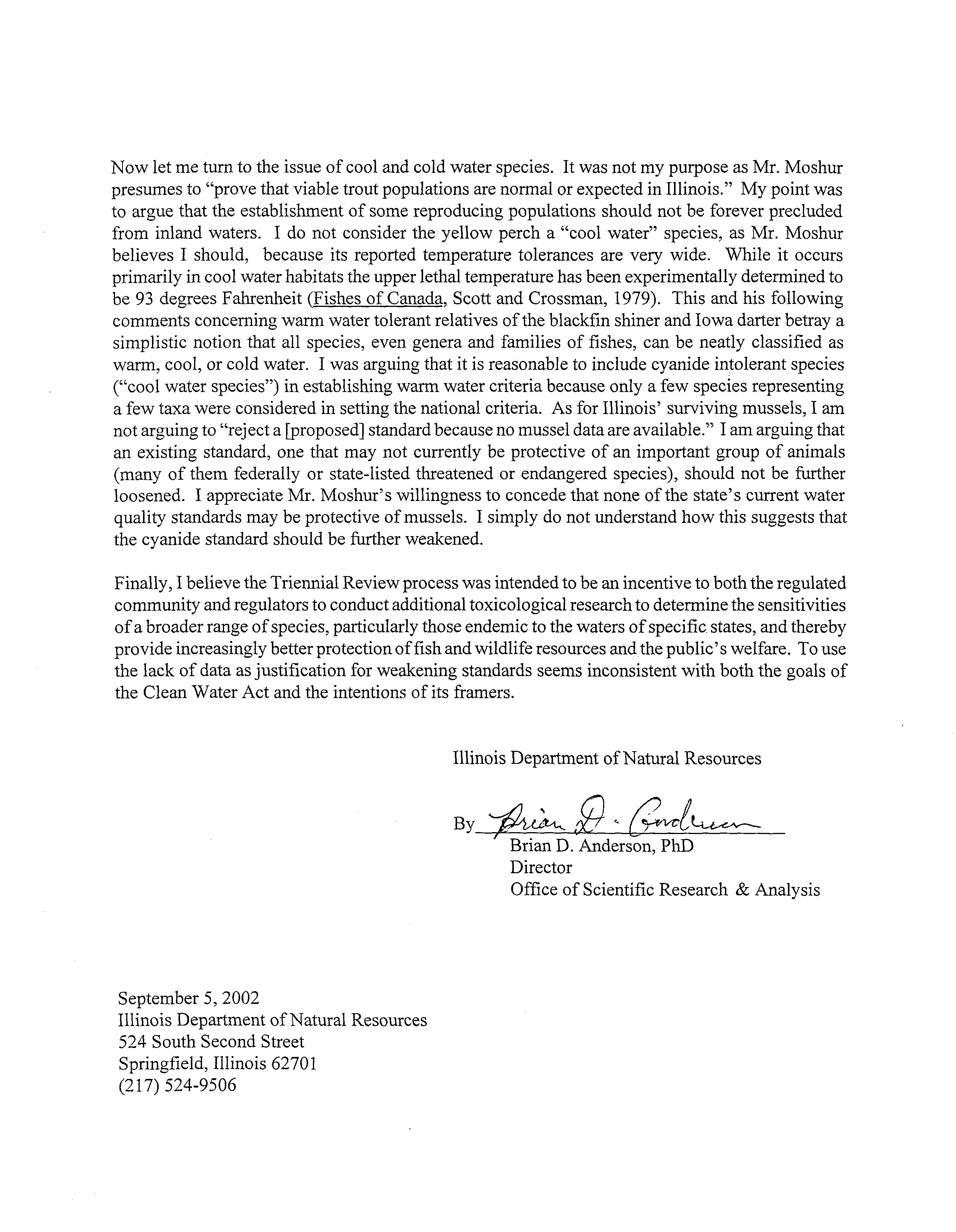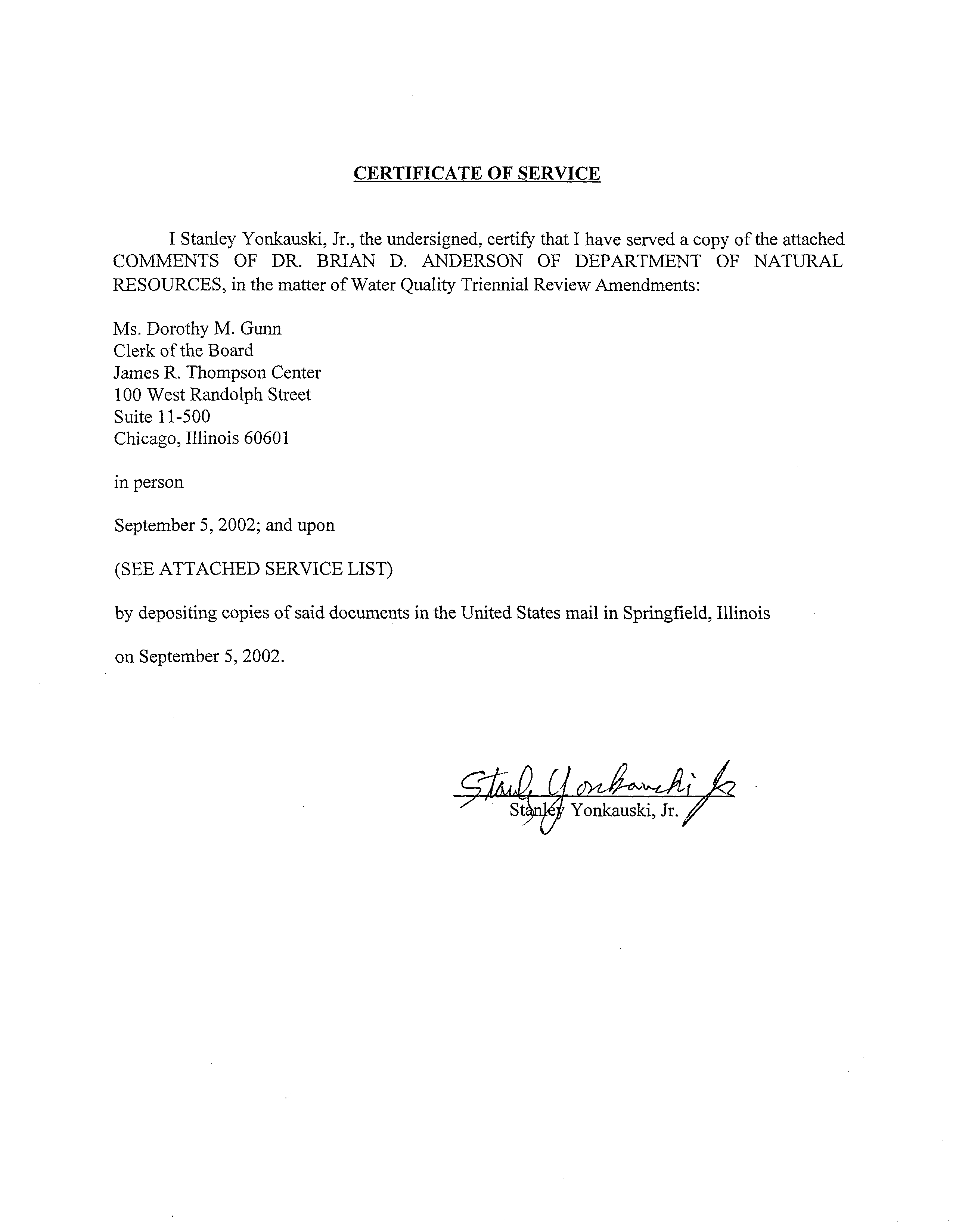RECEIVED
CLERK’S OFFICE
BEFORE THE ILLINOIS POLLUTION CONTROL BOARD
SEP
0 5 2002
STArE OF
IWNOIS
Pollution Control
Board
IN THE MATTER OF:
WATER QUALITY TRIENNIAL REVIEW)
AMENDMENTS TO
35
ILL.ADM.COM
302.208(e)-(g), 302.504(a),
302.575(d),303.444,309.141(h);
AND PROPOSED 35 ILL.ADM.CODE
301.267,
301.313,
301.413,
304. 120 AND
309.157
)
)
)
R02-11
)
(Rulemaking-Water)
~
)
)
)
)
2~2-
TO:
NOTICE OF FILING
SEE ATTACHED SERVICE LIST.
PLEASE TAKE NOTICE that on Thursday, September 5, 2002, we filed the attached
COMMENTS OF DR. BRIAN D. ANDERSON OF DEPARTMENT OF NATURAL
RESOURCES, with the Clerk ofthe Pollution Control Board, a copy of which is herewith served
upon you.
September 5, 2002
Stanley Yonkauski, Jr.
Legal Counsel
Illinois Department of Natural Resources
524 South Second Street, LTP
Springfield, Illinois 6270 1-1787
(217) 782-1809
ILLINOIS DEPARTMENT
OF
NATURAL RESOURCES,
By:
Stanley o
ski, Jr.
RECEIVED
CLERK’S OFFICE
BEFORE THE ILLINOIS POLLUTION CONTROL BOARD
SEP
2
STATE OF IWNO1S
Pollution Control Board
IN THE MATTER OF:
)
)
WATER QUALITY TRIENNIAL REVIEW
)
R02-1 1
AMENDMENTS TO 35 ILL. ADM. CODE
)
(Rulemaking-Water)
302.208(e)-(g), 302.504(a),
)
:j7 c__’.
~Z2—
302.575(d),
303.444, 309.141(h);
)
AND PROPOSED 35 ILL. ADM. CODE
)
301.267,301.313,301.413,
)
304.120AND309.157
)
COMMENTS OF THE ILLINOIS DEPARTMENT OF NATURAL RESOURCES
The backgound information Mr. Moshur provided in his written testimony ofJuly 10, 2002 to the
Pollution Control Board was useful in clarifying the current standard. Unfortunately his testimony
only reinforces the concerns the Department of Natural Resources expressed in our original
statement to the Board. Since the methodology was not cited, it was not clear to me from the
testimony presentedby the Agency thatthe national standard had already been weakened by adopting
a methodology that does not calculate total cyanide. The fact that Standard Method 4500-I “does
not release the more strongly bound forms of cyanide” is problematic since temperature and
exposure to light, as well as pH, may all cause dissociation ofcyanide compounds, and the species
of cyanide present in any given effluent may vary considerably. Thus, by adopting a standard that
is not based on measuring total cyanide, the margin of safety inherent in the national criteria has
already been eroded. It appears that the primary rational forproposing to again weaken the cyanide
standard is actually perceived problems with the analytic method. Mr. Moshur describes a single
situation (already addressed by a site-specific rulemaking) wherein he states, “Interferences were
presentthat resulted in false detections ofweak acid dissociable cyanide.” How does he knowthis?
Was the problem an inability to provide reproducible results? Were other tests for cyanide
conducted on the same samples for comparison? What “interferences” does he suspect? Were
controlled studies conducted to isolate potential variables? He further states,“These difficultiesexist
everywhere else in the state as well...,” yet he neither provides additional examples or evidence to
support his belief that the method lacks sensitivity at lower levels ofdetection. Either way, this
motive for requesting the further weakening ofthe existing standard should have been made plain
to the Board and the public as part ofthe original rulemaking.
Now let me turn to the issue ofcool and cold water species. It was not my purpose as Mr. Moshur
presumes to “prove that viable trout populations are normal or expected in Illinois.” My point was
to argue that the establishment of some reproducing populations should not be forever precluded
from inland waters. I do not consider the yellow perch a “cool water” species, as Mr. Moshur
believes I should, because its reported temperature tolerances are very wide. While it occurs
primarily in cool water habitats the upper lethal temperature has been experimentally determined to
be 93 degrees Fahrenheit (Fishes of Canada, Scott and Crossman, 1979). This and his following
comments concerning warm water tolerant relatives ofthe blackfin shiner and Iowa darter betray a
simplistic notion that all species, even genera and families of fishes, can be neatly classified as
warm, cool, or cold water. I was arguing that it is reasonable to include cyanide intolerant species
(“cool water species”) in establishing warm water criteria because only a few species representing
a few taxa were considered in setting the national criteria. As for Illinois’ surviving mussels, I am
not arguing to “rejecta proposed standard because no mussel dataare available.” I am arguing that
an existing standard, one that may not currently be protective of an important group of animals
(many of them federally or state-listed threatened or endangered species), should not be further
loosened. I appreciate Mr. Moshur’s willingness to concede that none of the state’s current water
quality standards may be protective ofmussels. I simply do not understand how this suggests that
the cyanide standard should be further weakened.
Finally, I believethe TriennialReview process was intended to be an incentiveto both the regulated
community and regulators to conduct additional toxicological researchto determine the sensitivities
ofa broaderrange ofspecies, particularly those endemic to the waters ofspecific states, and thereby
provideincreasingly better protection offish and wildlife resources and the public’s welfare. To use
the lack of data asjustification for weakening standards seems inconsistent with both the goals of
the Clean Water Act and the intentions of its framers.
Illinois Department ofNatural Resources
By
~
Brian D. Anderson, PhD
Director
Office of Scientific Research & Analysis
September
5,
2002
Illinois Department ofNatural Resources
524 South Second Street
Springfield, Illinois 62701
(217) 524-9506
CERTIFICATE OF SERVICE
I Stanley Yonkauski, Jr., the undersigned, certify that I have served a copy
of the attached
COMMENTS OF DR. BRIAN D. ANDERSON
OF DEPARTMENT OF NATURAL
RESOURCES, in the matter of Water Quality Triennial Review Amendments:
Ms. Dorothy M. Gunn
Clerk of the Board
James R. Thompson Center
100 West Randolph Street
Suite 11-500
Chicago, Illinois 60601
in person
September
5,
2002; and upon
(SEE ATTACHED SERVICE LIST)
by depositing copies of said documents in the United States mail in Springfield, Illinois
on September
5,
2002.
2~
St~r~t
(j~L~-~A
Yonkauski, Jr.
f
1/2
R02-11
SERVICE LIST
Ms. Dorothy M. Gunn
Illinois Pollution Control Board
100 West Randolph Street
Suite 11-5000
Chicago, IL 60601
Albert Ettinger
Environmental Law & Policy Center
35 East Wacker Drive, Suite 1300
Chicago, IL 60601
James T. Harrington
Ross & Hardies
150 North Michigan Avenue, Suite 2500
Chicago, IL 60601
Katherine Hodge
Hodge & Dwyer
3150 Roland Avenue
P.O. Box 5776
Springfield, IL 62705
Sanjay Sofat
Illinois Environmental Protection Agency
1021 North Grand Avenue East
Springfield, IL 62794-9276
Margaret Haward Hedinger and Howard
1225 South Sexth Street
Springfield, IL 62703
Robert Messina
Illinois Environmental Regulatory Group
215 East Adams Street
Springfield, IL 62701
Irwin Polls
metropolitan Water Reclamation
District of Greater Chicago
6001 West Pershing Road
Cicero, IL 60804
Marie E. Tipsord
Hearing Officer
Illinois Pollution Control Board
100 West Randolph, Suite 11-500
Chicago, IL 60601
Dennis Duffield
Department of Public Works
City of Joliet
921 E. Washington
Joliet, IL 60433-1267
Tom Muth
Fox Metro Water Reclamation District
682 State Route 31
Oswego, IL 60543
Mike Callahan
Bloomington Normal Water
Reclamation District
P.O. Box 3307
Bloomington, IL 6 1702-3307
Lisa Frede
Chemical Industry Council
9801 W. Higgins Road, Suite 515
Rosemont, IL 60018
Larry Cox
Downers Grove Sanitary District
2710 Curtiss Street
Downers Grove, IL 60515





